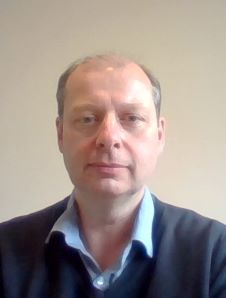Chris Fewster
Visit Chris Fewster's profile on the York Research Database to:
- See a full list of publications
- Browse activities and projects
- Explore connections, collaborators, related work and more
Profile
Biography
I studied in Cambridge as an undergraduate and PhD student, and then held postdoctoral positions in Bern and York, before being appointed here as a lecturer in 1998.
Departmental roles
Deputy Head of Department for Research
University roles
Former roles include:
- Member of University Teaching Committee (August 2002 - July 2005 and August 2014 - July 2016)
- Elected member of Senate (August 2007 - July 2008, August 2009 - July 2012 and August 2012 - July 2015)
- Chair of the University Standing Committee on Assessment, and member (ex officio) of the University Teaching Committee and the Board for Graduate Schools (January 2006 - July 2008)
Research
Overview
Most of my work concerns the mathematically rigorous formulation of quantum field theory (QFT) in curved spacetimes. In this theory, the propagation of the quantum fields is affected by the curvature of spacetime, but (usually) one neglects the "back-reaction" effect of the quantum fields on the spacetime. The mathematics involved in my work ranges across functional analysis, Lorentzian geometry and category theory.
I have four main areas of focus:
Measurement in quantum field theory Special relativity is incompatible with an instantaneous "collapse of the wavefunction" of the type often presented in accounts of measurement in quantum mechanics, because there is no absolute notion of simultaneity.
For this and related reasons, measurement theory for relativistic quantum fields has been plagued with apparent paradoxes. Recently, Rainer Verch and I have introduced a new framework that provides a clear basis for measurement in QFT and which, in work with Maximilian Ruep (a PhD student jointly supervised with Henning Bostelmann) has been shown to resolve one of the notorious problems in the subject. Work of this type is increasingly important as applications of quantum information become sensitive to relativistic effects.
Quantum energy inequalities Unlike most classical forms of matter, the local energy density of a quantum field can be negative. However, QFT contains mechanisms (deeply connected to the uncertainty principle) that result in the energy density not being too negative on average. These mechanisms are expressed by results called Quantum Energy Inequalities (QEIs). My contributions to this area include general and rigorous QEIs for a variety of free and interacting QFT models in both flat and curved spacetimes. An introduction to QEIs and some of the related techniques can be found in these lecture notes.
Locally covariant QFT Quantum field theory in Minkowski space depends in many ways on the high degree of spacetime symmetry. General curved spacetimes lack any symmetry at all, which makes it hard to prove general statements about general quantum field theories (as opposed to specific models). A major development was the introduction by Brunetti, Fredenhagen and Verch of a locally covariant formulation of QFT in curved spacetimes based on techniques of category theory. I have used this framework to give proofs of the spin-statistics connection, Coleman-Mandula theorem, and split property (sometimes in modified form) for general curved spacetimes, and also addressed the issue of whether a given locally covariant theory represents the same physics in all spacetimes. Much of this work is presented in a recent review, written with Rainer Verch.
Hadamard states Quantum field theory admits a very large space of states, most of which are unphysical. The class of Hadamard states is a well-studied set of physical states, which play an important role in QFT in curved spacetimes. Some of this work is described in this paper. They have an elegant characterization in terms of microlocal analysis, which I have used in my work on QEIs. Recently, Rainer Verch and I have shown that Hadamard states can be characterized - at least in some situations - by the property that the statistical distributions of measurement results for observables called Wick polynomials always have finite variances.
Research group(s)
Mathematical Physics and Quantum Information Research Group
Available PhD research projects
PhD supervision is available in any of the areas listed above, or more generally in quantum field theory in curved spacetimes.
Recent examples of PhD projects include:
- Simon Dawson (PhD 2006) investigated numerical QEIs and also produced the first closed-form expression for QEIs for the Dirac field in curved spacetime
- Calvin Smith (PhD 2006) obtained the first "absolute" QEIs in curved spacetimes
- Lutz Osterbrink (PhD 2007) found the first QEIs applicable to the nonminimally coupled scalar field
- Ko Sanders (PhD 2008) proved a Reeh-Schlieder theorem in the locally covariant context, and gave a locally covariant formulation of the locally covariant Dirac field and obtained a clear characterization of states on the extended Wick algebra
- Matthew Ferguson (PhD 2013) extended the concept of dynamical locality to Wick polynomials and further studied the Dirac field
- David Hunt (PhD 2012) gave a quantization of linearized gravity
- Benjamin Lang (PhD 2015) studied universal constructions in locally covariant theories with applications to electromagnetism and twisted fields
- Francis Wingham (PhD 2019, joint supervision with Kasia Rejzner) worked on SJ states of scalar and vector fields
- Michael Kiss (PhD 2021, joint supervision with Kasia Rejzner) studied the application of Fredenhagen's universal algebra construction to locally covariant QFTs, particularly in relation to topological aspects
- Maximilian Ruep (PhD 2023, joint supervision with Henning Bostelmann) proved that the measurement framework of myself and Verch resolves the "impossible measurement" problem first raised almost 30 years previously and unsolved until now
Supervision
Current Research Students
- Harkan Kirk-Karakaya - hkk506@york.ac.uk
- Diego Vidal Cruz Prieto - dvc501@york.ac.uk
- Berend Visser - bjv503@york.ac.uk
Teaching
Undergraduate
- General Relativity


